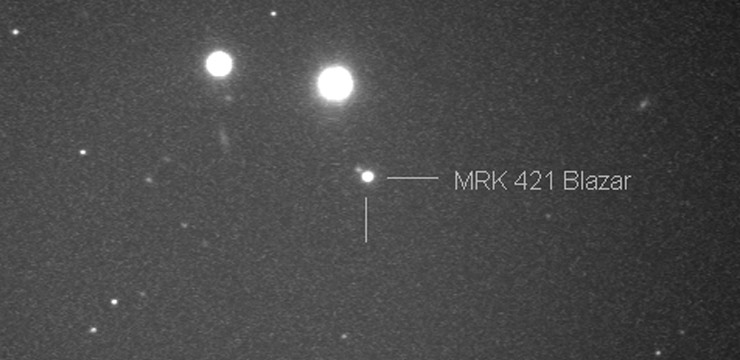A White Dwarf You can Actually See!
February 2009 :
Many of us have tried to spot the legendary faint companion to Sirius known as Sirius B, the so-called “Pup” star. Unfortunately, although separation in arc-seconds is now about 8.3” and is gradually widening, the brilliance of the primary (about 10,000 times brighter than its famous companion) usually washes out the white dwarf. True, there are a few observing tricks you can try to enhance your chances of resolving the B star and some observers occasionally report success in so doing, but it seems fair to say that only a very small percentage of amateurs will ever be able to claim they’ve glimpsed this well-known star. The year 2022 will offer the best opportunity, because it’ll be then that the magnitude 8.6 white dwarf moves to its most distant apparent position from the primary during an orbit calculated to be 50.1 years. Separation should then be just over 11”.
The inherent fascination of white dwarf stars owing to their exotic physical properties makes them highly prized observing targets for savvy amateurs. Information on such stars is readily available in a number of sources, so I’ll forego using much space here to outline the astrophysics, history of research, and history of observation relative to this stellar class, to which our own Sun will eventually belong. I should note, though, that about 53 years passed from the first actual observation of Sirius B in a telescope to the year in which its spectral type and estimated surface temperature were deduced, thus officially identifying the star—finally—as a white dwarf. (This confirmation by spectroscopy came about in 1915; the “Pup” had been seen by Alvan Clark’s son in 1862 during testing of a new 18.5” lens for a refracting telescope. The visual discovery was confirmed later that year, at Harvard.)
White dwarfs are hard to see because they’re generally rather dim, having low luminosity despite very high surface temperatures. This, in turn, is due to such small sizes that the total surface area of these stars is tremendously smaller than, for example, our own Sun. Average diameter for a white dwarf is thought to be about the size of Earth, plus or minus. Total luminosity radiated is thus far, far less than much larger stars. Add in a bright, close-by binary companion (as is the case for Sirius and Procyon) and a white dwarf becomes nearly invisible!
One particular star in northern Eridanus has a white dwarf companion that’s easy to spot, even in a small telescope. In fact, this dwarf is regarded as by far the easiest of its type to see in the entire sky, from even Ladd Observatory in Providence!
Approximately 14? due west of Rigel (Beta Orionis) amid the hard-to-identify chain of stars forming the dim outline of the mythical river Eridanus is a wide, naked-eye pair of similar brightness stars oriented diagonally to our view in February. The star at the northwest end of this pair is Omicron 1 Eridani, also called 38 Eri. It is magnitude 4.0 and is 0.4? east of a fainter star of magnitude 5.5 or so.
The other star at the southeast end of this diagonally arranged pair, about 1.2? away from Omicron 1, is our star of interest, Omicron 2 Eridani, also called 40 Eri. Position is RA 04h 15.3m, Dec. -07? 39’, magnitude 4.43. At a generous distance of 83” away will be seen Omicron 2B, confirmed positively as a white dwarf in 1910, the very first such star to be recognized as such through spectroscopy. Robert Burnham describes the history of observation in the chapter on Eridanus in volume 2 of his Celestial Handbook, always a good read even though information in his classic work is current only to 1977. Magnitude of the B star—the white dwarf—is 9.8.
There’s yet a third member of this system, a red dwarf of magnitude 10.8 at about 7.5” distance from Omicron 2B. The B-C pair has a period of around 250 years, while that of the A-B pair is thought to be over 7,000 years. Although a more difficult pair to make out, the B-C pair is fairly well seen in 4” scopes. So, now you’re up-to-date on how to find and actually see a white dwarf star—I hope you’ll find some enjoyment and interest in so doing. By the way, dwarfs at the centers of planetary nebulae are seldom seen in amateur-class scopes, but perhaps the best such object featuring the easiest seen central star is the Eskimo Nebula in Gemini, NGC 2392. (See the chapter on Gemini in Burnham’s volume 2.) My good friend Tim Dube, a planetary nebula guru from Douglas, Massachusetts, enthusiastically agrees with this choice.
When to Observe
Constellations
Related Topics




